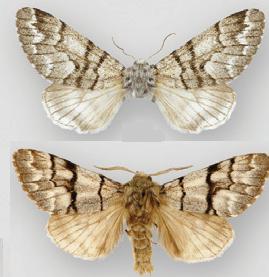Tufted white pine caterpillar facts for kids
Panthea furcilla is a type of moth often called the tufted white pine caterpillar or eastern panthea. It belongs to a family of moths called Noctuidae. You can find this moth across the northern forests of Canada, stretching west to the Rocky Mountains. It also lives in the eastern United States, from Maine all the way down to Florida. Its range goes west to Texas and north to Indiana and Ohio.
Quick facts for kids Panthea furcilla |
|
|---|---|
| Scientific classification | |
| Kingdom: | |
| Phylum: | |
| Subphylum: | |
| Class: | |
| Order: | |
| Family: | |
| Genus: | |
| Species: |
P. furcilla
|
| Binomial name | |
| Panthea furcilla (Packard, 1864)
|
|
| Synonyms | |
|
|
Contents
About the Panthea furcilla Moth
The Panthea furcilla moth has a wingspan of about 33 to 50 millimeters. This is roughly the length of a few paperclips lined up.
When Do These Moths Fly?
In Canada, these moths usually fly from June to August. They have one "brood" during this time. A brood means all the offspring that hatch at roughly the same time.
In the southern United States, they can have two or more broods. This means they have more generations of moths flying each year. The exact number depends on where they live.
What Do the Larvae Eat?
The larvae of the Panthea furcilla moth are caterpillars. These caterpillars like to eat the leaves of certain trees. Their favorite foods include:
- Eastern larch trees
- Various types of pine trees
- Spruce trees
Different Types of Panthea furcilla
Scientists have found two main types, or subspecies, of Panthea furcilla. These are slightly different versions of the same moth species.
Recognized Subspecies
- Panthea furcilla australis (named by Anweiler in 2009)
- Panthea furcilla furcilla (named by Packard in 1864)
There was once a supposed species called P. pallescens. However, scientists now believe it's just a different look or "form" of P. furcilla. It is not considered a separate species.



